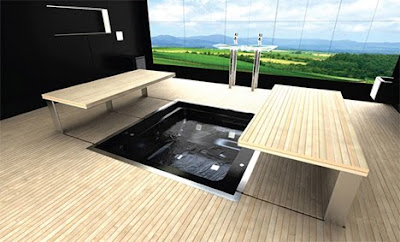Label:
Gadgets,
Technology Eindhoven, the Netherlands - The Emotions Jacket is a research platform that uses the sense of touch to take the cinematic experience to new levels, allowing viewers to experience the intense emotions felt by characters on-screen. While other viewing enhancement techniques focus primarily on audio and visual aspects, the Emotions Jacket instead stimulates the biggest, our heaviest and most sensitive sense; the human skin. This exploration is part of Philips’ wider ‘sensory experiences’ program.

Over the years, there have been many developments which have made the TV viewing experience more immersive. Examples include surround sound, widescreen, HD (high definition) and Philips Ambilight, which extends the picture beyond the confines of the screen and into the room. Philips has also introduced the Cinema 21:9 TV which is the world’s first cinema-proportioned television. All strive to bring cinematic scenes to life in the home. Until today, however, the focus has been on enhancing the impact of what the viewer sees or hears. The area of touch has remained relatively unexplored. By applying its core competencies in human perception and behavior, combined with its expertise in sensors and actuator technologies, Philips is investigating a new dimension in the immersive home cinema experience.
Focus on feel
The Emotions Jacket platform is a tightly fitting garment which incorporates a series of evenly-spaced actuators - based on the vibrator motors used in mobile phones - sewn into the arms and torso. By activating these actuators in response to what is happening on screen, it becomes possible to recreate certain feelings being experienced by the characters in the film. This is possible because research has shown that when people experience the physical manifestations of an emotion, they also experience the emotion itself. For example, fear sends a shiver down the spine, while excitement results in butterflies in the stomach. If you 'reverse engineer' this – i.e. you generate the shiver or the feeling in the stomach, then the associated emotion also occurs.
Total immersion
The result is that, when wearing the Emotions Jacket, viewers feel that they are truly part of the on-screen action, sensing for themselves the emotions experienced by the main character or others prominent in a particular scene. As Paul Lemmens, a scientist with Philips Research explains: “If you’re watching, say, a kung fu movie while wearing the Emotions Jacket, you won’t feel the physical punches and kicks, but you will experience the immense relief when the kung fu master escapes the evil henchmen.” Since touch is the only one of the five senses that is located all over the body, the viewing experience could scarcely be more immersive.
Touch and mood
Scientifically, the link between emotion and touch is still a relatively unexplored territory compared with the research conducted into the impact of images, sound and light. But what is known is that an individual’s own mood at any given time can dictate whether a touch feels comforting and intimate or unwanted and threatening. Philips’ research will focus on the challenge of how to induce the right stimuli to evoke a desired mood through touch. This could obviously have a major impact on health and well-being.
Future applications
Wider applications of the technology used in the Emotions Jacket are also conceivable. Sensors could be embedded into mattresses, baby mats or chairs to unobtrusively assess feelings and proactively anticipate needs. Actuators could then be used to positively stimulate certain moods, and in doing so creating an environment that feels safe and comfortable. As an example, it may be possible to sense when a baby is restless and then stimulate the right emotions to help it settle, without the need for parental intervention. Another possible application would be to de-stress patients in hospital or doctors’ waiting rooms. Other areas such as sleep and increased productivity are also being considered.
Implementing the technology
The Emotions Jacket - while marking an exciting potential advance in immersive entertainment - is only a platform on which to study the link between physical sensation and emotion. It is unlikely that any end product emerging from this research would require the viewer to wear it at all times when watching TV. It is also important to see this research in the context of Philips’ wider emotions research program. The first commercially-available results of this program hit the shelves last year with the release of the Philips Intimate Massagers in various countries throughout Europe.


 RSS Feed
RSS Feed Twitter
Twitter 5:43 AM
5:43 AM
 SHAZIA MALIK
SHAZIA MALIK


















